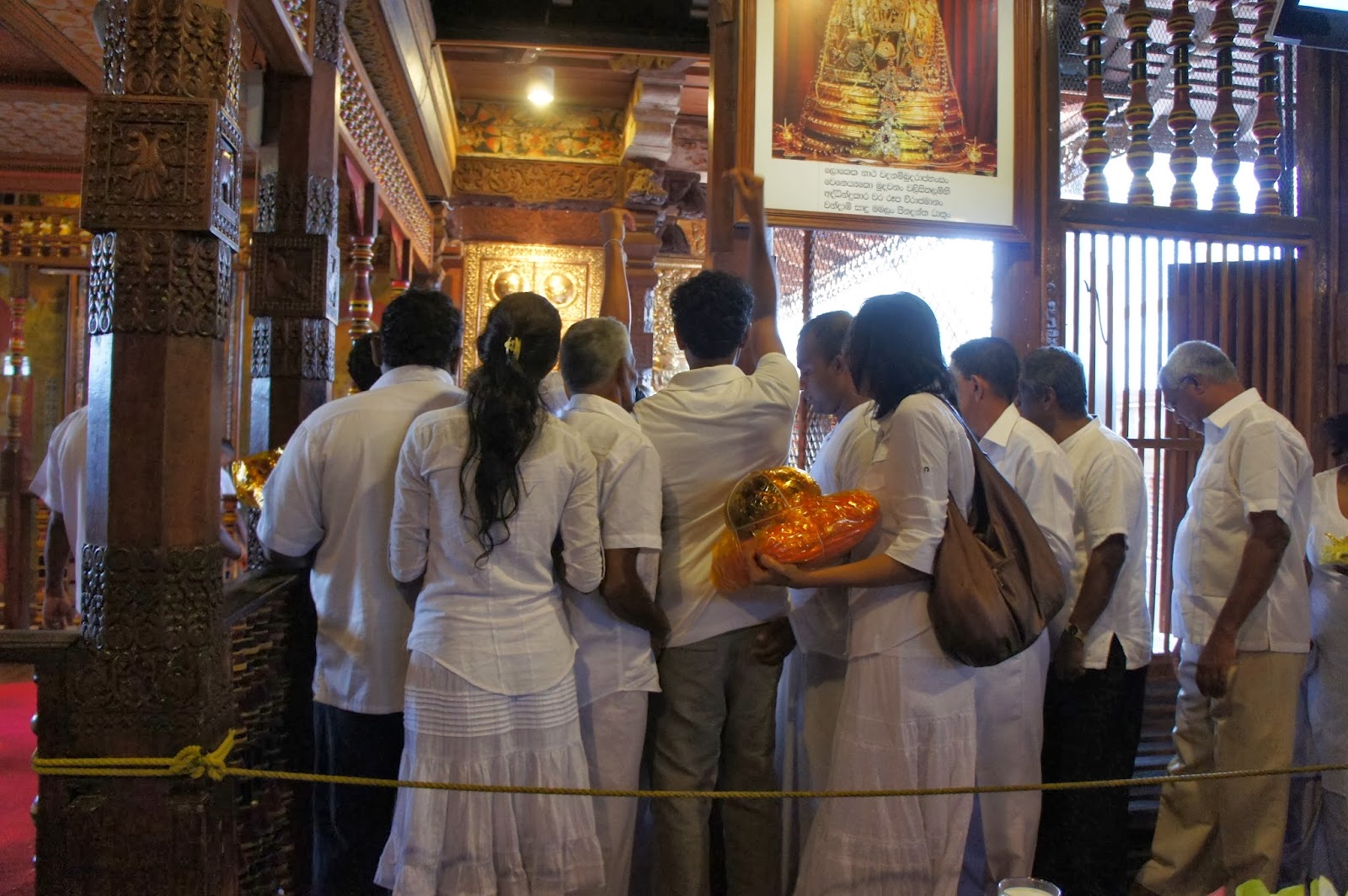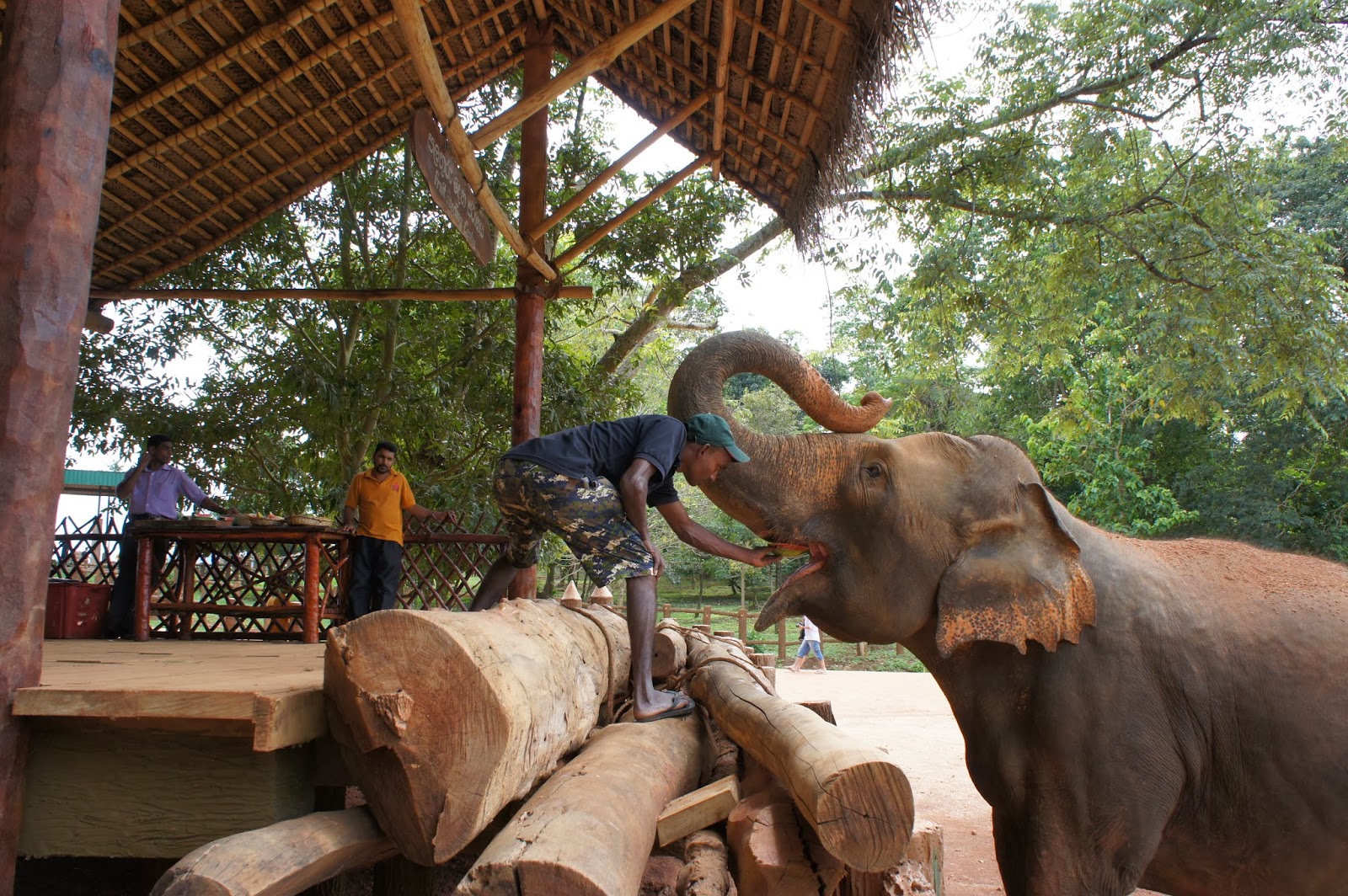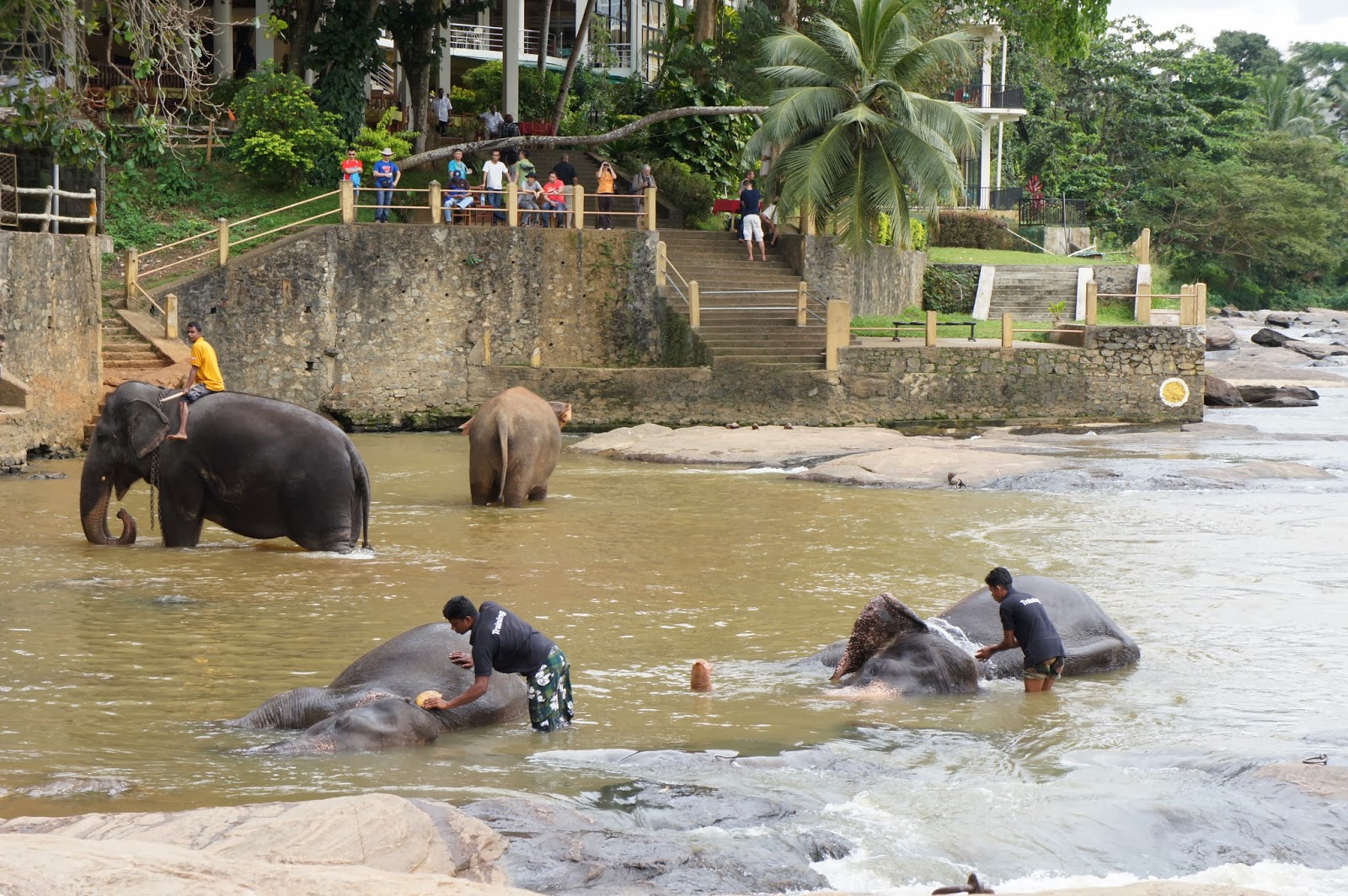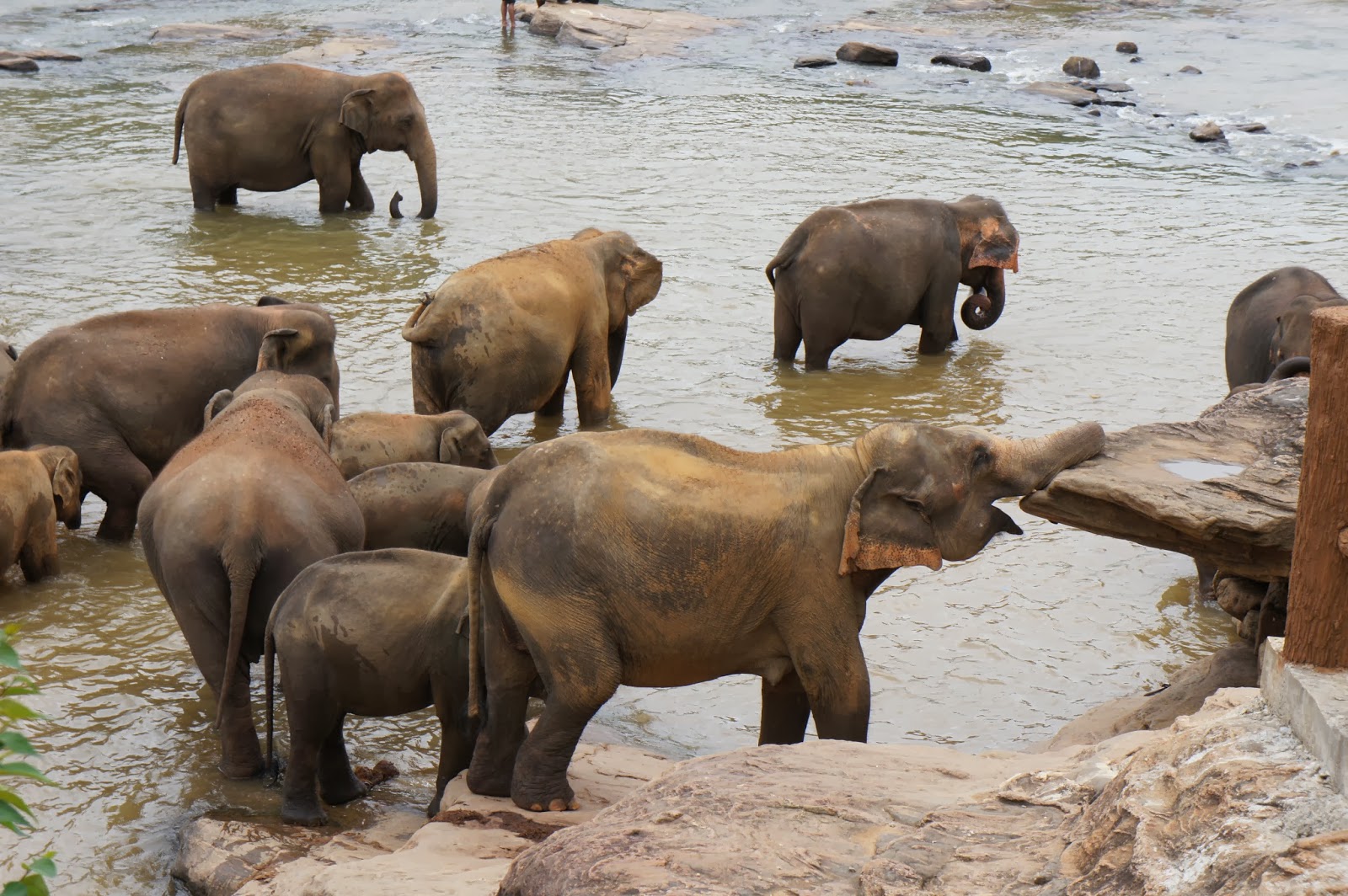Back in Kandy we had a bit of a sleep in after two early mornings and a lot of driving. Our plan for the day was the visit the Sacred Temple of the Tooth (Sri Dalada Maligawa) for the 9:30am Thewawa (puja), followed by a trip to the Pinnewala Elephant Orphanage. We hired our guesthouse owner, Jude, to drive us around for the day (as Pinnewala is over 40 km away from Kandy). After a huge breakfast, we finally made it to the Temple at 20 minutes to 11, which Jude said was fine because the Thewawa would last until 11:30am. There are three Thewawa ceremonies daily, 5:30am, 9:30am and 6:30pm and these are the only times that the heavily guarded room to the tooth is open for viewing. However, the tooth is kept in a gold casket shaped like a dagoba, so it's never actually seen itself.
So by now you are likely wondering what the deal is with this sacred tooth - well it is supposedly a tooth from Buddha himself, said to have been snatched from the flames of his funeral pyre in 543 BC and smuggled to Sri Lanka in the 4th century AD hidden in the hair of a princess. It is one of Sri Lanka's most sacred religious relics and most Sri Lankans believe they must make at least one pilgrimage to the temple in their lifetime. The tooth was first brought to Anuradhapura and was moved around across the country to various temples. It was even captured and "destroyed" by the Portuguese (but the Sinhalese claimed it was a fake that they captured).
We made our way through security (and check to make sure our clothing was appropriate - knees and shoulders covered), and past some of the surrounding shrines and temples. The complex is surrounded by a massive fence following a 1998 car LTTE car bomb that was detonated during the long civil war. The bomb killed twenty people and left the facade of the complex to rubble.
Worshippers
The Temple of the Tooth complex (the temple with its gold roof)
We checked our shoes (we got very used to walking around the dirt barefoot in Sri Lanka!), bought our tickets, and crossed the moat to the temple complex.
The moat (much of this area was rebuilt after the 1998 LTTE bomb).
Hallway to the Temple
Worshippers sitting in front of the casket in which a replica of the Tooth Relic is paraded during the Esala Perahera festival
We headed up the stairs to where the entrance to the tooth relic chamber is. On the way we passed by another couple, both with big cameras who were taking their time and photographing people as they walked up. When we got up the stairs there was no line up to see the tooth relic and we were quickly waved to go through. We were herded through quite quickly and told not to take any photos of the tooth relic itself. We passed by the door and quickly glanced in to see a gold pagoda relic. As soon as we passed by, they shut the door! The other couple who had been taking their time taking photos got upstairs and were told it was too late to see the relic! Our guesthouse owner had been wrong - the morning puja only went until 11am (and we had arrived up there at exactly 11!). Lucky us!
Worshippers outside the Sacred Temple of the Tooth
Worshippers with their offerings of flowers in Handunkudama, the passage that precedes the shrine chamber
Walking towards the open door to view the tooth relic (where I was told to hurry and to not take a photo of the relic itself). The door is the open bit just right of the red image.
The closed door to the relic chamber (the brass door in the centre)
Worshippers waiting to enter the tooth relic chamber with offerings after the door was closed
Worshipper with offerings
Worshippers
Packed area in the Handunkudama chamber full of devotees
The main tooth shrine from down below - a two storey building known as Vahahitina Maligawa (the chamber entrance is on the second storey)
Vahahitina Maligawa
Vahahitina Maligawa
Vahahitina Maligawa
Moonstone at the entrance of Alut Maligawa, a newer shrine hall built in 1956 behind the Vahahitina Maligawa
Guardstone
Alut Maligawa - a sequence of 21 paintings hung around the chamber's upper walls depict the story of the Tooth Relic from Buddha's death to the present day
Alut Maligawa
Alut Maligawa
Alut Maligawa
Stairs leading up to Alut Maligawa
Buddha in Alut Maligawa
Ceiling adorned with elephant heads in Alut Maligawa
Workers repairing the Temple of the Tooth
Worshippers outside
Every year in July or August (depending on the full moon), one of Sri Lanka's largest festival happens in Kandy, called the Esala Perahera. The festival dates back to the arrival of the Buddha's tooth in the fourth century AD and lasts for 10 days, complete with cultural dances, decorated elephants, and of course the procession of the tooth relic (though now and days it is a replica). The tooth relic is carried around by a Maligawa Tuskar, an elephant which must fulfil certain physical requirements - the elephant must be male and must be a Sathdantha elephant, meaning that all seven parts of their body (four legs, trunk, penis and tail) must touch the ground when they stand upright. The tusks must be formed in the curved shape of a traditional winnow and it must have a flat back and be twelve feet tall.
Sri Lanka's most famous elephant was Raja, who served as Kandy's Maligawa Tusker for fifty years before passing away in 1988. Since Raja, no other single elephant has proved worthy to replace him and so the role is shared between various different elephants. It has been increasingly difficult to find these high caste elephants locally.
The remains of Raja were stuffed and are on display at the Raja Tuskar museum, so we popped by to pay our respects to Raja.
Raja
Flowers for sale at the entrance to the complex
Outside the complex
Dave and the complex in the background (the tooth relic is housed under the gold roof)
We met out guesthouse owner, and driver for the day, outside the complex and hopped into his car to drive to Pinnewala Elephant Orphanage in time for the 1:15pm feeding. I had read that we could buy a ticket to bottle feed a baby elephant ourselves and wanted to get there in time to do that.
Hitting a bit of traffic, we cut it close and arrive at 1:10pm. We bought our tickets and asked for a ticket for the feeding, but they were all sold out. I was incredibly disappointed, but ended up being glad that we didn't waste our money once we got to the feeding area and saw what it was all about.
The Pinnewala Elephant Orphanage was established in 1975 to care for orphaned elephants that were found in the wild. While there are still some orphaned elephants at Pinnewala, the centre has largely turned into a breeding centre and tourist attraction (while most of the orphaned elephants in Sri Lanka now get sent to the Elephant Transit Home adjacent to Udawalawe Park). The "orphanage" misses out on a great opportunity to educate its guests with little to no information whatsoever about the inhabitants or elephants at all.
Upon arrival, we quickly ran over to the baby elephant feeding area where a group of baby elephants were chained up surrounded by watchful tourists and waiting to be fed. Workers and tourists took their turns bottle feeding these animals. The ones not being fed at the moment were tugging on their chains and appearing distressed. For a first introduction, we just felt sad for them.
Tourist bottle feeding a baby elephant
Baby elephants chained up and appearing distressed
Tugging away on its chain
After having enough of watching the poor baby elephant, we wandered over to another enclosure where there were four elephants: a nursuing mother and baby, a deformed elephant, and another disabled elephant who was being propped up. We had read about an elephant who lives there whose leg had been blown off by a land mine.
Nursing baby
This may have been the elephant whose foot was blown off from a land mine
Or possibly this one?
Our first thoughts of the Pinnewala elephant orphanage were that all these poor elephants were chained up. As we moved along we were pleased to see this was not the case. (And I later read that after the bottle feedings the babies are also let free).
Unchained elephant being fed
The rest of the elephants were hanging out in this clearing. Mahouts were inviting people to get up close to pose for photos for a tip, but we kept our distance and took our free photos.
We spent awhile just watching the elephants interact with one another - its amazing how long you can watch these beautiful creatures without getting bored.
Dave was enamoured
The mahouts then led the elephants down 05 km away to the river for their baths. They seemed quite excited to get down there.
The elephants heading off to the river for their bath
They crossed the street,and made their way down the road, past the vendors.
We were stopped until they reached the river and then our tickets were checked and we were let past.
The elephants were left to just enjoy the river, with the mahouts only intervening if they wandered too far.
The watching area
Beautiful creatures
Some of the elephants were brought over to the side for a thorough scrub down (we assume they do a few at each bath time). They seemed pretty content getting pampered.
Curious elephant came over to say hi
Ah, that's the spot
Another curious guy
Fully clean and heading back
Little guy getting into trouble
Mmm, rock
After watching them in the river for about an hour, I finally had to drag Dave away (he was quite enamoured by these creatures). It was pretty amazing to watch them all enjoying themselves. In terms of the elephant "orphanage" itself, I'm a bit divided. The elephants are not in cages, it's heaps better than being in a zoo or confinement, but they are chained up at night and mahouts do occasionally have to use their sharp metal hooks in order to train the elephants. And in terms of passing it off as an orphanage, it's very misleading since it is mostly a breeding centre now. The elephants are treated relatively well, but many of them are bred and provided to temples or similar and once they are gone to the captive market there is no guarantee of their welfare. If you are interested in more information to make an informed decision about whether to visit the Pinnewala Elephant Orphanage, bornfree.org has a failry objective assessment here.
After our elephant watching, we hopped back into the car for the ride back to Kandy.
Feet poking out the truck in front of us
Lookout
Roadside stall
The Highway museum complex - construction of the Colombo to Kandy road was completed in 1820, considered a marvel in British engineering
Highway museum complex
Our last stop was the Bahiravakanda Buddha - the statue was completed in 1993 and constructed on the request of President Premadasa, who was killed a few months later in Colombo by an LTTE suicide bomber.
Bahiravakanda Buddha
View of Kandy from the top of the Buddha
They love their sacred Bodhi trees
Carvings inside
View to the other side of Kandy
























































































No comments:
Post a Comment